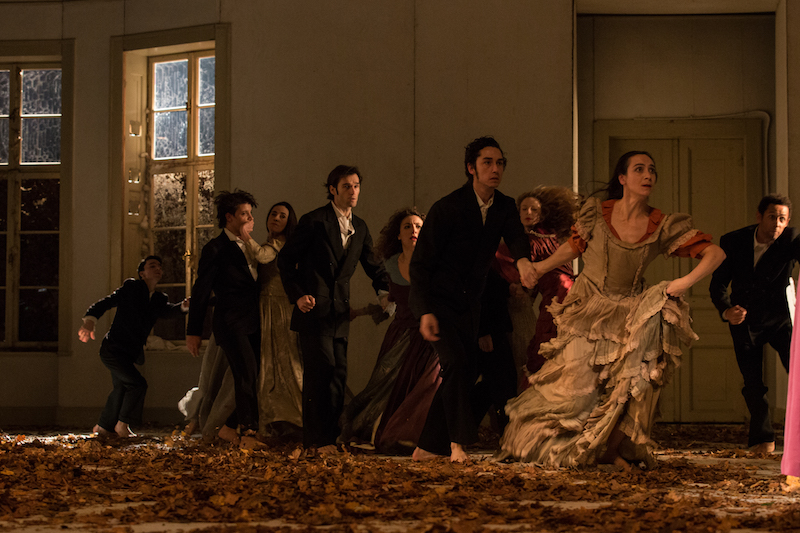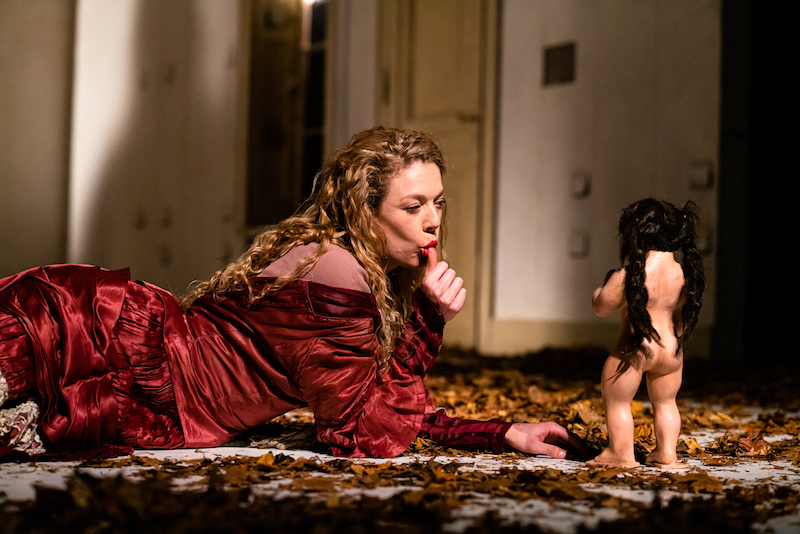Ten years on from the death of its founder-choreographer, the Pina Bausch company finds itself at a crossroads, unwilling to limit itself to endless revivals of hits such as Café Muller or Rite of Spring, yet equally unwilling to relinquish the back catalogue altogether. Current artistic director Bettina Wagner-Bergelt tells theartsdesk why the time is right to bring back an early masterpiece, unperformed for 29 years. Highly experimental, violent and tender by turns, Bluebeard focusses on the hopeless lack of understanding between men and women.
JENNY GILBERT Why Bluebeard, and why now?
BETTINA WAGNER-BERGELT It was in the course of Bluebeard’s creation that Pina developed the working processes that would define the rest of her career, so it's a significant piece. It stopped being performed because Bartok's inheritors didn’t like the way his music was being used, so withdrew their permission. But now, 70 years after Bartok's death, it's out of copyright, in Germany and the UK at least. So from 1 January this year we were free to stage Bluebeard again.
In 1977, Pina had been employed as choreographer at the Wuppertal Opera for, what, just three years when she made it? Was she already a disruptive force?
Yes she was a revolutionary, and she divided audiences. There were people who liked her work but there were plenty who walked out of her productions, slamming doors. On this occasion she was keen to tell her version of the Bluebeard story, but the Wuppertal opera orchestra was not so keen to play Bartok’s score. So she decided to go ahead using a tape machine to relay the music, an old fashioned reel-to-reel model. The medium became central to the story, as the Bluebeard character repeatedly rewinds and fast-forwards in a maniacal attempt to change the course of fate, or history, to get women to love him. He is a manipulator in more ways than one. With his finger on the button, it’s he who keeps the music going.
Taped music must have seemed outlandish on an opera stage in 1977
Well it probably still does. Plus it's a very emotional piece and seems chaotic, because there are so many people running around on stage. As well as Bluebeard and his new wife Judith, there are six other couples who all interfere in their story. At the same time there is a very strong choreographic concept. The chaos builds and builds and then suddenly, like a freeze-frame in a film, it stops, and they switch to doing the same choreography, very formally and precisely. And then it explodes again, and the story goes on. The form that Pina developed for this piece is very special, but it still concerns two main characters. It was after this she decided she wanted to put every member of the company in the spotlight, because she found them all equally fascinating. That’s when she started her practice of asking questions and setting the dancers tasks.
 So Bluebeard is a turning point?
So Bluebeard is a turning point?
Yes, Pina's main concern at this time was to find a form for expressing her ideas, because such a form didn’t yet exist. It was when she was in New York that she got the idea of parallel observations, of watching many things happening at once. You could look anywhere and find a story, multiple stories. Everywhere you looked there were couples, there were interactions. When she arrived at Wuppertal in the 1970s her intention was never to provoke. She was just searching for a language – to say something that couldn’t be said in words.
The main characters in Bluebeard are multiplied and mirrored by six other couples. Did Pina invent the idea of fragmenting the dramatic focus like that?
B W-B: As far as I know, yes, she was the first. These ideas existed only in literature. In Berlin Alexanderplatz for example, or in the novels of Christa Wolf, with their flashbacks and changing points of view. People complained – we can’t follow this! There’s so much going on, you never know where to look or whose story to follow! There were others, though, who accepted that they might not follow everything all of the time, but they opened themselves to the experience. Pina would sometimes use words, for instance, not for their meaning but for their sound, like having someone say something in Chinese. The company has always been diverse, from all over the world, and she tapped into this richness of cultural experience. She felt this allowed her to express the complexity of modern life.
Repetition is another prominent feature in her work – actions repeated almost beyond endurance. In Bluebeard there’s a woman falling and the man failing to catch her, over and over again. Had she done that before?
The falling woman became a recurring feature in Pina’s pieces. It came from her observation of other people’s relationships, a pattern she observed, of people trying and trying to achieve something, and still it doesn’t work. In Bluebeard, the women plead with their lovers “love ME love ME love ME!” and you want to say to them, “Leave him! Can’t you see he’ll never love you the way you want him to?”. But they persist. And the other way round, the man tries to get closer to these women but it’s a perverted love, it can only destroy them. It’s this constant fight between the sexes for intimacy, for love. And that’s what this piece is about.
 Tell me about the movement in this piece. Was it the first time she used violence on stage?
Tell me about the movement in this piece. Was it the first time she used violence on stage?
B W-B: Yes, it was a first. In Rite of Spring, which she made before this, the violence is more covert, delivered via the choreography, more formalised. Here the brutality is acted out. They really go for it. But alongside it there is this really strong choreographic element, almost classical. There are also beautiful movements that come out of the Kurt Joos tradition that Pina had worked with as a dancer herself. And you can see Pina’s own movement style emerging in this piece – the long arms, the focus on the upper body. But the most striking thing is the effect of collective movement.
Did the original cast accept the violence without protest?
B W-B: They complied, but I think they really had a hard time, and it still is hard. I’m seeing that now as I watch them rehearse. This piece demands that the performers actually go through these emotions, and it’s hard doing such terrible things to another person. You have to keep telling yourself that this is theatre, it isn’t real. Yet at the same time Pina never wanted people to “act” or pretend on stage. So the line is very very fine between being the person you are, and being Bluebeard or Judith. Psychologically, it’s very demanding.
How do you limit injury when rehearsing?
B W-B: We have techniques. To take an example, the running into a wall, which looks so alarming and became a feature in many of Pina’s pieces. It has to look as if you’re really smashing into it, it has to look believable. So, we developed a technique involving a cushion inserted between the body and the wall at the last moment, but the arms and hands smack the wall with force to give the impression and sound of the whole body hitting it.
How did you go about reviving a work that's not been done for nearly 30 years? Is there reliable video of the original performance?
B W-B: We now have an archive here in Wuppertal set up by Pina’s son Salomon, which is wonderfully useful. In the case of Bluebeard there are five videos of various vintages that our directors use. But now that Pina is not here it’s they who finally have to decide how we do it: to say this is the right placement, the right timing, the right relationship, the right mood. The videos are only impressions of single performances, and not without mistakes.
Running into a wall, it has to look as if you’re really smashing into it, it has to look believableAre intention and motivation more important than steps?
Equally important, and that’s where we’re so lucky to have key members of the original cast on board. They remember everything that Pina told them. And when they are gone too? Then I would hope that Pina’s work can be passed down just as other great works of dance are, from one generation of performers to another. But all works of dance, since the 19th century, have changed. Dancers’ bodies have changed, our perceptions and tastes have changed. The world has changed. Bluebeard was a scandal when it first came out. People were frightened and shocked. And I’m curious about how it will be received now. Sexual violence is no longer the taboo subject it was in the 1970s. It’s part of public discourse now.
So will that change the impact of this piece?
We shall see. It's also interesting to me how today’s young dancers find their way through this, because the image of the macho male is less prevalent than it was in 1977, and young women are more sure of themselves, less intimidated. They find Bluebeard’s attitudes and behaviour ridiculous. They’re more likely to say: who does that guy think he is?
What all Pina Bausch fans are wanting is to see more and more of the older pieces, but the company wants to generate new pieces. Can that circle ever be squared?
It's a problem, certainly. Pina’s work will always be central. And dancers will always crave the input of contemporary artists. It’s not difficult to combine both in our home seasons in Wuppertal, ideally in a proportion of 3:1. It's more difficult on tour, but we’re determined to find a solution. My concern is that the contemporary artists we work with have the same ethical standards as Pina. This ensemble works in a very intimate way that depends hugely on trust, and also on being allowed enough time to work in depth on each project. These were Pina’s values that I’m determined to keep.














Add comment